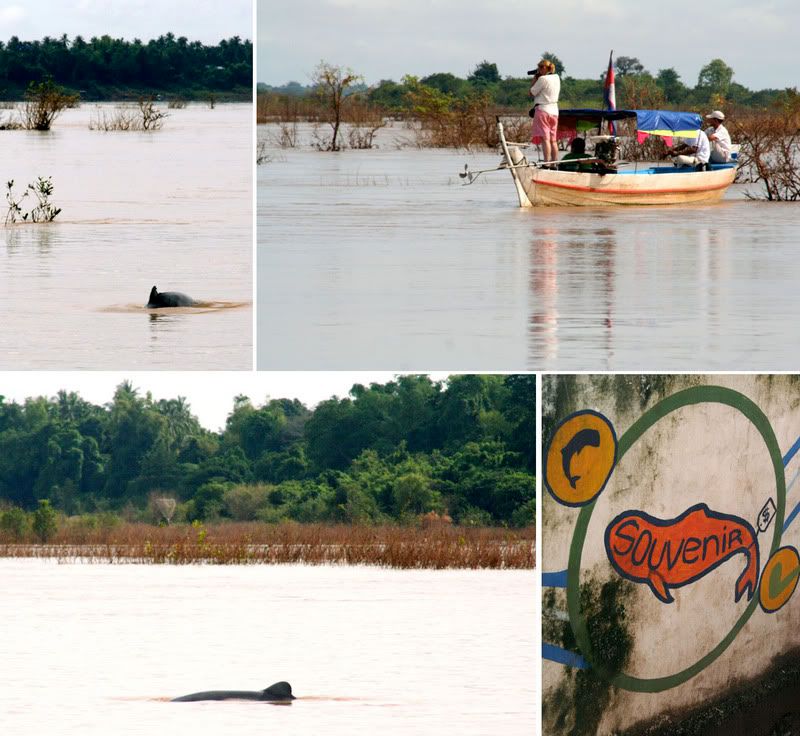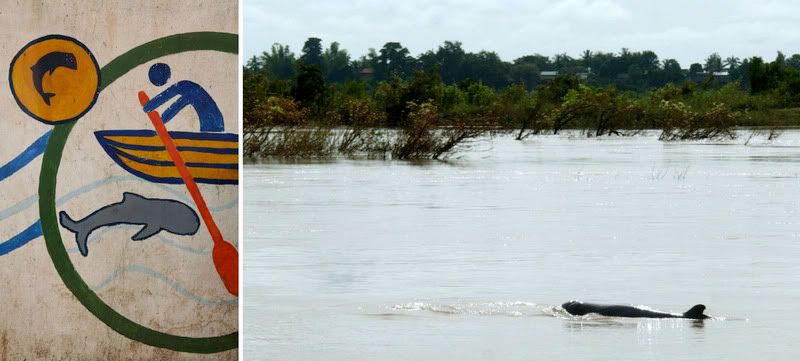One of the highlights of visiting the area around Laos-Cambodian border is the chance to see the rare Irrawaddy dolphins that live in the Mekong. According to the guidebooks, the dolphins have a special place in local mythology- they're very close to humans, with reports that they have performed heroic deeds, like saving people from crocodiles. For the community living in the area today, they mainly represent a local source of eco-tourism. During the dry season, they can occasionally be spotted in Laos, among the shallow waters around the 4000 islands. During the wet season, it's much easier to see them in Cambodia, where they live in colonies around sunken islands.

Having spent a beautiful but rough week in Southern Laos- no good coffee or muesli!- the Cambodian town of Kratie welcomed us with an array of simple but comforting Western pleasures. The dining highlight of Kratie was the cafe at the Star Guesthouse. It was situated in a corner spot, across from the food market. Over breakfast or lunch, we watched the goings-on at the fruit stands, and admired the bundles of green bananas that hawkers lugged by. The cafe had a wide range of coffees, good sandwiches using imported ingredients, and my staple breakfast, muesli and yogurt. Kratie itself was a pleasant town, with aged and faded French architecture, and a packed market selling fresh fish and colorful fruit. Just a few blocks away from the town center, and the neighborhoods become starkly more rural; bamboo and wooden stilt houses replaced concrete apartment blocks, and horse drawn carts plodded between moto traffic. The town also had a beautiful location along a wide stretch of the Mekong, which was best viewed from the promenade at sunset, as the golden light filtered through the colonnade of trees.

The dolphins are best seen from Kampie, a small town roughly 15 minutes moto ride from Kratie. The road out was easily one of the most interesting part of the trip. The were beautiful wood homes, with ornately carved accents on the roof and along the eaves; tiny bamboo houses, perched on stilts over muddy water; and all of this piled along the road against a backdrop of intensely green rice paddies. As the moto slowed down, I easily spotted the entrance to the dolphin site; there was a tacky dolphin statue, fading in the tropical sun. We paid the entrance fee, which had risen to about $7 US (well worth it, especially if it actually goes toward protecting the dolphins' habitat)- that included a boat trip with local guides, who were required not to use motors or to chase the dolphins.

From the dock, it was a ten minute boat trip out to the deeper pools that the dolphins favor. I had been worried that we wouldn't see any dolphins- perhaps still thinking of my elephant-less visit to the elephant tower at Ban Na- so I was very surprised how quickly we saw the first dolphin. It's silver fin sliced out of the water, and it disappeared again. I was confused by the fact that the boat driver didn't stop, and didn't seem to pay it any attention- but when we got to our destination, I saw why. We anchored the boat, and watched the water. The dolphins were everywhere. They would appear in pairs, the two fins usually rising in unison. They aren't as playful or as outgoing as their bottlenose relatives, but they still came fairly close to the boat. Occasionally they would show themselves long enough for me to see their distinctive blunt noses and bulbous heads. We watched them for an hour, during which time I tried unsuccessfully to get a good photo. Thankfully, the experience of seeing these strange and rare river creatures more than made up for that.
 Having spent a beautiful but rough week in Southern Laos- no good coffee or muesli!- the Cambodian town of Kratie welcomed us with an array of simple but comforting Western pleasures. The dining highlight of Kratie was the cafe at the Star Guesthouse. It was situated in a corner spot, across from the food market. Over breakfast or lunch, we watched the goings-on at the fruit stands, and admired the bundles of green bananas that hawkers lugged by. The cafe had a wide range of coffees, good sandwiches using imported ingredients, and my staple breakfast, muesli and yogurt. Kratie itself was a pleasant town, with aged and faded French architecture, and a packed market selling fresh fish and colorful fruit. Just a few blocks away from the town center, and the neighborhoods become starkly more rural; bamboo and wooden stilt houses replaced concrete apartment blocks, and horse drawn carts plodded between moto traffic. The town also had a beautiful location along a wide stretch of the Mekong, which was best viewed from the promenade at sunset, as the golden light filtered through the colonnade of trees.
Having spent a beautiful but rough week in Southern Laos- no good coffee or muesli!- the Cambodian town of Kratie welcomed us with an array of simple but comforting Western pleasures. The dining highlight of Kratie was the cafe at the Star Guesthouse. It was situated in a corner spot, across from the food market. Over breakfast or lunch, we watched the goings-on at the fruit stands, and admired the bundles of green bananas that hawkers lugged by. The cafe had a wide range of coffees, good sandwiches using imported ingredients, and my staple breakfast, muesli and yogurt. Kratie itself was a pleasant town, with aged and faded French architecture, and a packed market selling fresh fish and colorful fruit. Just a few blocks away from the town center, and the neighborhoods become starkly more rural; bamboo and wooden stilt houses replaced concrete apartment blocks, and horse drawn carts plodded between moto traffic. The town also had a beautiful location along a wide stretch of the Mekong, which was best viewed from the promenade at sunset, as the golden light filtered through the colonnade of trees. The dolphins are best seen from Kampie, a small town roughly 15 minutes moto ride from Kratie. The road out was easily one of the most interesting part of the trip. The were beautiful wood homes, with ornately carved accents on the roof and along the eaves; tiny bamboo houses, perched on stilts over muddy water; and all of this piled along the road against a backdrop of intensely green rice paddies. As the moto slowed down, I easily spotted the entrance to the dolphin site; there was a tacky dolphin statue, fading in the tropical sun. We paid the entrance fee, which had risen to about $7 US (well worth it, especially if it actually goes toward protecting the dolphins' habitat)- that included a boat trip with local guides, who were required not to use motors or to chase the dolphins.
The dolphins are best seen from Kampie, a small town roughly 15 minutes moto ride from Kratie. The road out was easily one of the most interesting part of the trip. The were beautiful wood homes, with ornately carved accents on the roof and along the eaves; tiny bamboo houses, perched on stilts over muddy water; and all of this piled along the road against a backdrop of intensely green rice paddies. As the moto slowed down, I easily spotted the entrance to the dolphin site; there was a tacky dolphin statue, fading in the tropical sun. We paid the entrance fee, which had risen to about $7 US (well worth it, especially if it actually goes toward protecting the dolphins' habitat)- that included a boat trip with local guides, who were required not to use motors or to chase the dolphins. From the dock, it was a ten minute boat trip out to the deeper pools that the dolphins favor. I had been worried that we wouldn't see any dolphins- perhaps still thinking of my elephant-less visit to the elephant tower at Ban Na- so I was very surprised how quickly we saw the first dolphin. It's silver fin sliced out of the water, and it disappeared again. I was confused by the fact that the boat driver didn't stop, and didn't seem to pay it any attention- but when we got to our destination, I saw why. We anchored the boat, and watched the water. The dolphins were everywhere. They would appear in pairs, the two fins usually rising in unison. They aren't as playful or as outgoing as their bottlenose relatives, but they still came fairly close to the boat. Occasionally they would show themselves long enough for me to see their distinctive blunt noses and bulbous heads. We watched them for an hour, during which time I tried unsuccessfully to get a good photo. Thankfully, the experience of seeing these strange and rare river creatures more than made up for that.
From the dock, it was a ten minute boat trip out to the deeper pools that the dolphins favor. I had been worried that we wouldn't see any dolphins- perhaps still thinking of my elephant-less visit to the elephant tower at Ban Na- so I was very surprised how quickly we saw the first dolphin. It's silver fin sliced out of the water, and it disappeared again. I was confused by the fact that the boat driver didn't stop, and didn't seem to pay it any attention- but when we got to our destination, I saw why. We anchored the boat, and watched the water. The dolphins were everywhere. They would appear in pairs, the two fins usually rising in unison. They aren't as playful or as outgoing as their bottlenose relatives, but they still came fairly close to the boat. Occasionally they would show themselves long enough for me to see their distinctive blunt noses and bulbous heads. We watched them for an hour, during which time I tried unsuccessfully to get a good photo. Thankfully, the experience of seeing these strange and rare river creatures more than made up for that.

No comments:
Post a Comment